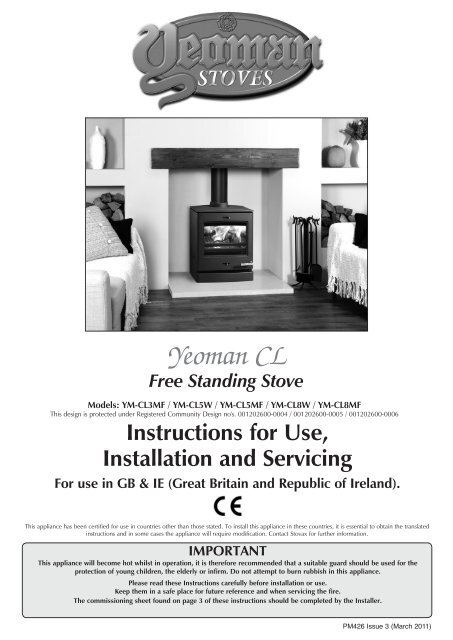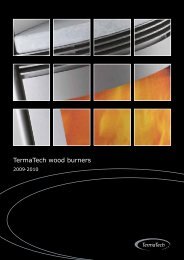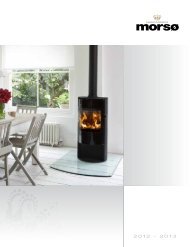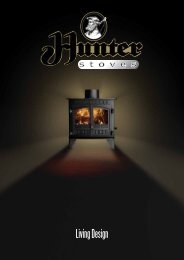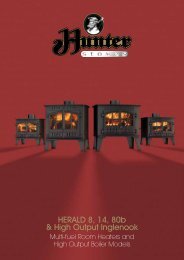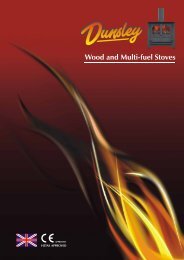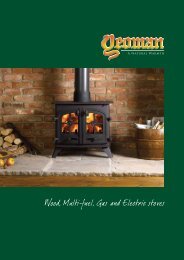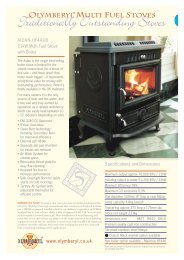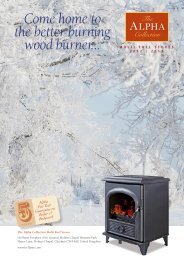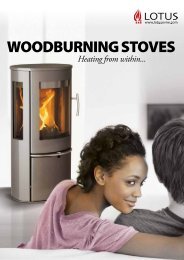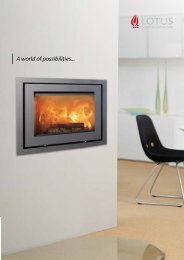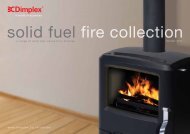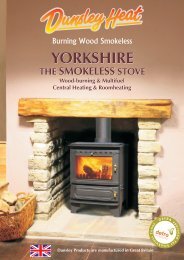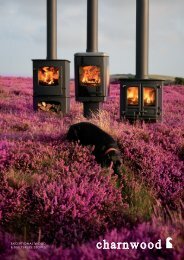Yeoman CL - The Stove Yard
Yeoman CL - The Stove Yard
Yeoman CL - The Stove Yard
- No tags were found...
You also want an ePaper? Increase the reach of your titles
YUMPU automatically turns print PDFs into web optimized ePapers that Google loves.
<strong>Yeoman</strong> <strong>CL</strong>Free Standing <strong>Stove</strong>Models: YM-<strong>CL</strong>3MF / YM-<strong>CL</strong>5W / YM-<strong>CL</strong>5MF / YM-<strong>CL</strong>8W / YM-<strong>CL</strong>8MFThis design is protected under Registered Community Design no's. 001202600-0004 / 001202600-0005 / 001202600-0006Instructions for Use,Installation and ServicingFor use in GB & IE (Great Britain and Republic of Ireland).This appliance has been certified for use in countries other than those stated. To install this appliance in these countries, it is essential to obtain the translatedinstructions and in some cases the appliance will require modification. Contact Stovax for further information.IMPORTANTThis appliance will become hot whilst in operation, it is therefore recommended that a suitable guard should be used for theprotection of young children, the elderly or infirm. Do not attempt to burn rubbish in this appliance.Please read these Instructions carefully before installation or use.Keep them in a safe place for future reference and when servicing the fire.<strong>The</strong> commissioning sheet found on page 3 of these instructions should be completed by the Installer.PM426 Issue 3 (March 2011)
COVERING THE FOLLOWING Models:Models: YM-<strong>CL</strong>3MF / YM-<strong>CL</strong>5W / YM-<strong>CL</strong>5MF / YM-<strong>CL</strong>8W / YM-<strong>CL</strong>8MFAPPLIANCE COMMISSIONING CHECKLIST 3USER INSTRUCTIONS 4General Points 4Using the Appliance for the first time 5Recommended Fuels 5Lighting the Appliance 6Running the Appliance 7Burning Tips 8Ash Removal 9Extended Burning 9Over-Firing 9Chimney Fire 9General Cleaning 9Cleaning Glass 10Chimney Sweeping 10Care of <strong>Stove</strong> 10Seasonal Use 10Troubleshooting Tips 11Smoke Control Kit 11COMMISSIONING 24MAINTENANCE & SERVICING 25Annual Service 25Removal of Log Guard 26Removal of Firebricks 26Removal of Baffle 26Fitting a New Glass Door 26Fitting a New Door Seal 27Adjusting Door Catches & Hinges 28SPARES LIST 29SERVICE RECORDS 32EC DE<strong>CL</strong>ARATION OF CONFORMITY 33INSTALLATION INSTRUCTIONSTECHNICAL 12Technical Specifications 12Standard Features 12Packing List 12Dimensions 13SITE REQUIREMENTS 14Flue & Chimney 14Flue Exit Positions 15Hearth Dimensions 15Walls Next to Hearth 16PRE-INSTALLATION 17Flue 17Ventilation 17Fitting Appliances on a Boat 18INSTALLATION 19Legal Requirements 19Installing the Appliance 19Top Flue Installation 19Rear Flue Installation 20Removal of Log Guard 20Fitting & Removal of Firebricks 21Fitting & Removal of Baffle 21Removal of the Riddling Mechanism 21Hearth Fixing 22Fitting Cast Top 23CO Alarm 23 This appliance has been approved by HETAS Ltd.WARRANTYYour Stovax retailer provides you with a Two Year Warranty foryour new product. However, this specifically excludes naturallywearing parts or ‘consumables’ and the use of unauthorised fuels.Some Stovax products will also qualify for a Five Year Warrantyon cast iron parts such as cast iron carcasses and cast iron doors ofsteel bodied stoves. Again, this excludes naturally wearing cast ironparts.For these extended warranties to be valid your stove must havebeen installed in accordance with the manufacturer’s instructionsand the second and subsequent year’s warranties are dependanton the appliance being serviced within 12 months of installation byan appropriately qualified engineer and annually thereafter.Please check the Warranty Statement on the Stovax web-site forup-to-date list of conditions. 2
APPLIANCE COMMISSIONING CHECKLISTTo assist us in any guarantee claim please complete the following information:-Retailer appliance was purchased fromName:..................................................................................................................................................................Address:...........................................................................................................................................................................................................................................................................................................................................Telephone number:..............................................................................................................................................Essential Information - MUST be completedDate installed:......................................................................................................................................................Model Description:..............................................................................................................................................Serial number:......................................................................................................................................................Installation EngineerCompany name:.....................................................................................................................................................................Address:.................................................................................................................................................................................................................................................................................................................................................................................Telephone number:................................................................................................................................................................Commissioning Checks (to be completed and signed)Is flue system correct for the appliance YES NOFlue swept and soundness test complete YES NOSmoke test completed on installed appliance YES NOSpillage test completed YES NOUse of appliance and operation of controls explained YES NOInstruction book handed to customer YES NOSignature:........................................................................................Print name:...............................................................3
USER INSTRUCTIONS1. General POINTS1.1 Before use of this appliance please read theseinstructions fully.<strong>The</strong> appliance must be fitted by a registered installer*, orapproved by your local building control officer.Data Plate1.2 All local regulations, including those referring to nationaland European Standards need to be complied with wheninstalling the appliance.1.3 Only use for domestic heating in accordance with theseoperating instructions.1.4 You must burn only approved fuels. Do not use with liquidfuels or as an incinerator.1.5 Appliance surfaces become very hot when in use. Usea suitable fireguard if young children, elderly or infirmpersons are present.Stovax offer firescreens, sparkguards and hearthgate systemsfor protection‡. Your <strong>Yeoman</strong> retailer can advise you aboutthese products.1.6 Do not place photographs, TV’s, paintings, porcelain orother combustible items on the wall or near the appliance.Exposure to hot temperatures will cause damage.1.7 Extractor fans or cooker hoods must not be placed in thesame room or space as this can cause appliance to emitfumes into the room.1.8 Do not obstruct inside or outside ventilation required forthe safe use of this appliance.1.9 Do not make unauthorised changes to the appliance.PR8745<strong>The</strong> data plate is found on a swing out data plate locatedon the back of the stove on the left hand side (seeDiagram 1).Triple Air SystemsAIR CONTROLSThis <strong>Yeoman</strong> appliance has a triple air system, providingcleaner burning and greater efficiency and control (seeDiagram 2).1) Airwash - air drawn over the window cleans the glass.<strong>The</strong> source of Primary Combustion air when burning wood.2) Primary Air - for use with solid fuel and when lightingwood fires.3) Cleanburn - secondary air is preheated through a heatexchanger to combust unburned hydrocarbons, providing acleaner and more efficient burn.1.10 <strong>The</strong> chimney must be swept at least once a year (see UserInstructions, Section 13).1.11 Do not connect, or share, the same flue or chimneysystem with another appliance.1.12 This appliance is designed to be used with the doors shut.SERIAL NUMBER1.13 This number is required when ordering spare parts ormaking warranty claims. It is found on the appliance dataplate.‡In the U.K. these products must conform to the latestedition of BS 8423, Fireguards for use with solid fuelappliances.If appliance is operating unattended they must conform tothe latest edition of BS 3248.*Registered on the Competent Persons Scheme (GB only)see page 26 / INFO (Republic of Ireland).PR8702For Air Controls see the diagram over.Use the tool provided to operate the air controls.Do not place tool on hot surfaces (e.g. top of stove).4
USER INSTRUCTIONS<strong>CL</strong>OSEAirwash ControlOPEN—All open flued appliances can be affected by temporaryatmospheric conditions which may allow fumes toenter the house. Because of this an electronic carbonmonoxide detector conforming to the latest editionof BSEN50291 must be fitted in the same room asthe appliance. <strong>The</strong> existence of an alarm must not beconsidered a substitute for ensuring regular servicingand maintenance of the appliance and chimney system.If the alarm sounds follow the instructions given underWarning above.PR8721Primary Control<strong>CL</strong>OSEOPENDOOR OPERATION1.14 Use a protected gloved hand to operate.DO NOT OPEN THE DOOR WITH BARE HANDSTo Open and CloseRotate handle and pull door to openPR87222. USING THE Appliance FOR THE FIRSTTIME2.1 To allow the appliance to settle, and fixing glues and paintto fully cure, operate the appliance at a low temperature forthe first few days.2.2 Do not touch the paint during the first period of use.2.3 During this time the appliance may give off someunpleasant odours. Keep the room well ventilated to avoida build-up of fumes.2.4 Please be aware that, during use, rope seals may discolour.This is normal.3. RECOMMENDED FUELS3.1 Wood LogsPR8723WARNINGPR8724Burn only seasoned timber with a moisture content of lessthan 20%. To ensure this allow cut wood to dry for 12 to18 months.Wood LengthProperly installed, operated and maintained thisappliance will not emit fumes into the room.Occasional fumes from de-ashing and refuelling may occur.Persistent fume emission is potentially dangerous andmust not be tolerated.If fume emission does persist:—Open doors and windows to ventilate the room.Appliance<strong>CL</strong>3<strong>CL</strong>5<strong>CL</strong>8Wood Length200mm330mm400mm—Allow fire to burn out and safely dispose of fuel from theappliance.—Check for chimney blockage and clean if required.—Do not attempt to relight until the cause of the emissionhas been identified and corrected.Poor quality timber:—Causes low combustion efficiency.—Produces harmful condensation.—Reduces effectiveness of the airwash and life of theappliance.If necessary seek expert advice.5
USER INSTRUCTIONS5.12 Do not burn bituminous coal, ‘petro-coke’ or otherpetroleum based fuels, as this invalidates the productguarantee.Do not load fuel above the log guard and the secondarycombustion inlets at the back of the firebox(see Diagram 6).6. Burning tips6.1 Fuel Quality (Wood)Use wood with a moisture content of less than 20%.Seasoned logs have the bark beginning to lift and peel awayand cracks radiating from the centre. <strong>The</strong>y feel lighter thanfresh cut wood of a similar size and sound hollow whenstruck against each other. Logs should not feel damp orhave moss and fungal growths.Symptoms related to wet wood:—Difficulty starting and keeping a fire burning well.—Smoke and small flames.—Dirty glass and/or firebricks.—Rapid creosote build-up in the chimney.—Low heat output.—Short burn times, excessive fuel consumption andblue/grey smoke from the chimney.Burn at a high temperature for a short period each dayto avoid large build-ups of tars and creosote within theappliance and the flue system.Use Stovax Protector chimney cleaner to reduce thisproblem.6.2 Fuel Quality (Solid Fuel)Use recommended solid fuels approved for use with closedappliances.Symptoms related to unsuitable fuels include:—Difficulty starting and keeping a fire burning well.—Smoke and small flames.—Dirty glass and/or fire bricks.—Short life span for Grate, Baffle and internal Firebricks.—Permanent staining of glass.6.3 Air inlets puffing smokeCombustion gases can build up in the firebox and igniteas small explosions, causing smoke to puff out of the airinlets and other openings. This occurs if the air controlsare shut soon after adding new fuel to a very hot fire. Stopby opening the air controls to increase combustion air andburning rate.6.4 Flue Draught<strong>The</strong> chimney has two main functions:1) To safely remove the smoke, gases and fumes from thehouse.2) To provide a sufficient amount of draught (suction) in theappliance ensuring the fire keeps burning.Draught is caused by the rising hot air in the chimney whenthe appliance is lit.Symptoms of poor performance related to flue draughtinclude:—Excessive fuel consumption (high flue draught).—Poor burning control, overheating (high flue draught).—Wind noise from air controls (high flue draught).—Difficulty getting a fire going and keeping it burning well(low flue draught).—Low heat output (low flue draught).—Smoke entering room when doors opened (low fluedraught).<strong>The</strong> construction, position, size and height of the chimneyall affect the performance of the flue draught.Other factors effecting the flue draught include:—Trees or other buildings nearby causing turbulence.—Outside temperature.—Outside weather conditions.—Incorrect additional ventilation to building.—Blocked flue / chimney.For advice on the correction of persistent flue problemsconsult a qualified solid fuel heating engineer beforecontinuing to use the appliance.6.5 Weather conditions<strong>The</strong> weather conditions outside the building can effect theburning performance of the appliance. <strong>The</strong>se could include:Weather Conditions Problem EffectWindy daysBuildings/Obstaclescause turbulent airaround chimney.Smoky ApplianceCalm days Oversized Chimney. Smoky ApplianceDamp / Rainy daysFlue temperaturenot hot enough.Rain water insidechimney.To reduce these problems:Lighting andburning problems—Use good quality kindling wood to start the fire.—Burn initially at a high temperature for a short period.—Fit a rain cowl to the chimney.Your installer should advise you on possible solutions.If the appliance emits smoke into the room continuously:—Close the air controls and allow the appliance to go out.—Ventilate the room to clear the fumes.Do not re-light the appliance until the problem is solved.8
USER INSTRUCTIONSCheck for obvious build up of soot, ash or debris above theflue baffle(s) (these can be found in the upper part of thefirebox). Use a torch if necessary.If there are any signs of a build up of debris above the fluebaffle(s) either:—Arrange for the chimney to be swept (see UserInstructions, Section 13).—Remove the baffle and clear the debris (see InstallationInstructions, Section 4).To refresh painted finishes use Stovax Riva Midnight blackmetallic paint.Wipe dry with a soft clean cloth be fore relighting. Alwaysdry appliance to avoid rust.Do not use abrasive cleaner or cleaning pads.Check that the door shuts properly and creates an effectiveseal. Leaking door seals prevent the appliance workingproperly.13.2 <strong>The</strong> chimney, any connecting flue pipe and the applianceflue ways, if incorporated, must be regularly cleaned.13.3 Ensure adequate access for cleaning where it is not possibleto sweep through the chimney.13.4 If the chimney is believed to have previously served anopen fire it must be swept a second time within a month ofregular use after installation.14. Care of stoveStovax has a range of cleaning and maintenance productsand accessories to keep your appliance in good workingorder. Your Stovax retailer can advise you on suitable itemsfor your stove and provide genuine spare parts such asreplacement glass, door sealing rope and firebricks. Viewthe extensive range at www.stovax.com by clicking onAccessories. In addition, an annual service by a competentengineer is recommended to keep your stove in the bestpossible condition.Do not use aerosol sprays near an operating appliance.12. <strong>CL</strong>EANING GLASSKeep the glass clean with correct use of the Airwash systemand good quality fuel.12.1 Sometimes additional cleaning may be required.This can be done as follows:—Allow appliance to cool fully. Do not clean hot glass.—Use a soft cloth and suitable cleaner.12.2 Do not use cleaning agents that have a high alkalinecontent, for example Stovax Gel Cleaner, on applianceswith painted glass such as the Studio, View or <strong>CL</strong>. <strong>The</strong>seare abrasive cleaning agents that are designed to be usedwith heavily stained clear glass. Use Stovax Glass Cleaner(Stovax No.4103) on more delicate surfaces.Do not use acidic cleaners on printed glass.12.3 Before re-lighting the appliance dry the glass fully.13. CHIMNEY SWEEPING13.1 To maintain safe and efficient use of the appliance, thechimney/flue must be inspected and swept at least once ayear by a qualified chimney sweep**.If the appliance is used continuously throughout the year,or it is used to burn wood or smokeless fuel, more frequentsweeping is recommended.<strong>The</strong> best time to have the chimney swept is at the start ofthe heating season.<strong>The</strong> above applies even if burning smokeless fuels.15. Seasonal use15.1 Clean and service the appliance if it is not used during thewarmer periods of the year, as detailed in the Maintenanceand Servicing section.15.2 Set the air controls to 50% to keep the appliance ventilatedand stop the build-up of any moisture inside.15.3 Before re-lighting the appliance:—Remove the baffle.—Clear any debris that may have accumulated.—Check the flue is clear of any blockages.In the U.K.* Registered on the Competent Persons Scheme (GB only)see page 11 / INFO (Republic of Ireland).** This should be done by a HETAS registered chimneysweep, see page 11, who will issue you with a certificate.10
SITE REQUIREMENTSWALLS NEXT TO A HEARTHSolid, non-combustiblematerial e.g. masonry orconcreteThickness WH150mmminimumCC150mmminimumPR8731Position of Appliance & Hearth in relation to wallsRequirement for the wallsDistance of hearth from wall'C'Distance of Appliance to wallMin thickness of Wall'W'Min height of wall'H'0mm0mm0mm - 50mm51mm - 300mm200mm75mmHeight of appliance + 300mmOr1200mm from the hearth (take largestdimension)0 - 150mm 150mm + 75mm 1200mm150mm + 300mm + No Minimum RequirementSuitable clearance should be allowed around the stove to enable the correct fitting and maintenance of the appliance.Any clearances should be confirmed by making a site survey and a physical check of wall thickness and dimensions.16
PRE-INSTALLATION CHECKS1. FlueModel<strong>Yeoman</strong> <strong>CL</strong>3 - YM-<strong>CL</strong>3MF<strong>Yeoman</strong> <strong>CL</strong>5 - YM-<strong>CL</strong>5W / YM-<strong>CL</strong>5MF<strong>Yeoman</strong> <strong>CL</strong>8 - YM-<strong>CL</strong>8W / YM-<strong>CL</strong>8MF<strong>Yeoman</strong> <strong>CL</strong>3<strong>Yeoman</strong> <strong>CL</strong>5<strong>Yeoman</strong> <strong>CL</strong>8Flue / Chimney SizeFlue / Chimneyminimum height*Without Liner SystemRound (diameter)Without Liner System (square)Minimum DimensionWith Liner or Factory MadeSystem (diameter)mm 150 150 150inch 6 6 6mm 135 135 135inch 5½ 5½ 5½mm ‡150 150 150mm ‡6 6 6m 4 4 4feet 13 13 13*When measured from the top of the flue, with no horizontal sections and a maximum of 4 bends with angles of less than 45°‡May be 125mm (5") if burning low volatiles (smokeless) fuels approved for use in Smoke Control Areas.See web site http://uksmokecontrolareas.co.uk for more information about approved fuels.2. VENTILATION2.1 This appliance requires a constant supply of air to maintainproper combustion and effective flue performance.2.2 An inadequate air supply can result in poor combustion andsmoke entering the room which is potentially dangerous.2.3 This supply of air can come from either:—<strong>The</strong> natural leakage of air into the room in which theproduct is fitted.—Purpose provided ventilation.—Some Stovax appliances can also be fitted with anoptional outdoor air kit which allows air to be drawn infrom the outside.Modern building techniques have reduced the amount of airthat leaks in or out of a house. A modern construction withan air tightness of less than 5m 3 per hour per m 2 requires anair vent for ALL solid fuel appliances including those with arated heat output of less than 5kW.NOTE: <strong>The</strong> air leakage of a modern house is tested at thecompletion of construction and a certificate issued confirmingthis.2.4 <strong>The</strong> amount of air required must comply with local buildingregulations and the rules in force.2.5 If spillage is detected during commissioning then there maybe insufficient natural ventilation and an additional air supplywill be necessary.2.6 Many older buildings are sufficiently ventilated by naturalleakage of air to provide suitable air supply for an applianceof 5kW output or less.17
INSTALLATION INSTRUCTIONSLegal requirementsBefore installation and/or use of this appliance pleaseread these instructions carefully to ensure that allrequirements are fully understood.<strong>The</strong> appliance must be fitted by a registered installer*,or approved by your local building control officer.1.1 Take care when installing the appliance. Carelesshandling and use of tools can damage the finish and/orarea.Choose top or rear flue exit (see Diagram 1).Hexagonal BoltsHexagonal Nuts& WashersIt is very important to understand the requirements of thenational Building Regulations† and standards‡, along withany local regulations and working practices that may apply.Should any conflict occur between these instructions andthese regulations then the regulations must apply.Your local Building Control Office can advise regarding therequirements of the regulations.<strong>The</strong> appliance must be fitted by a registered installer* orapproved by your local building control officer.Works must be carried out with care to meet therequirements of Health and Safety** and comply withthe Health and Safety rules**, and any new regulationsintroduced during the lifetime of these instructions.Particular attention should be drawn to:—Handling: <strong>The</strong> appliance is heavy. Adequate facilitiesmust be available for loading, unloading and on sitehandling.—Fire Cement: Some fire cement is caustic and must notcome into contact with the skin. Protective glovesmust be worn. Wash hands thoroughly with plenty ofwater after contact with skin.—Asbestos: This appliance contains no asbestos. If thereis the possibility of disturbing any asbestos in thecourse of installation seek specialist guidance and useappropriate equipment.—Metal Parts: Take care when installing or servicing thestove to avoid personal injury.A faulty installation can cause danger to the inhabitantsand structure of the building.TopPR8007Rear—Fit flue collar and blanking plate to suit.PR8732—Attach flue collar to top or rear with hexagonal bolts (seeDiagram 1).—Seal with fire cement.—Secure blanking plate with hexagonal bolts(see Diagram 2).Hexagonal Nuts& WasherPR8732For users of this appliance:Your building insurance company may require you toinform them that a new heating appliance has beeninstalled on your property. Check that your cover is stillvalid after installing the appliance.1. INSTALLING THE ApplianceEach installation is unique to the property so it is notpossible to give details to suit every setting. <strong>The</strong> installationmust comply with Building Regulations† and be made usingbest practice construction methods.Many fireplace openings have a supporting lintel. Do notremove without supporting the remaining structure of thebuilding. Do not support the structure with the applianceor the flue system.1.2 Top flue pipe installation:—Lift appliance into position, taking care not to damagethe hearth finish.—Level the appliance.—Connect appliance to the chimney using flue pipe.—Secure with self tapping screw.—Seal the connecting joints.† England and Wales – Document J / Scotland - Part F/Document J (Republic of Ireland only)‡ the latest edition of BS 8303, BS EN 15287, BS 7566*Registered on the Competent Persons Scheme (GB only)see page 11 / INFO (Republic of Ireland).**Health and Safety at Work Act 197419
INSTALLATION INSTRUCTIONS—Secure with self tapping screw.—Seal the connecting joints.Do not use a 90˚elbow to make this connection.<strong>The</strong> flue must be installed in accordance with manufacturersinstructions.PR8009Seal Collar with Fire CementSelf tapping screw<strong>The</strong> flue must be installed in accordance withmanufacturers instructions.Flue Pipe 915mm (3ft)SizeStovax Part No.‡ 5" 4502TeeSize Stovax Part No.‡ 5" 45166" 46166" 4602CapSelf tappingscrew at rearSeal flue collarwith Fire CementPR8735To chimney connectionas detailed in buildingregulationsPR8733To chimney connectionas detailed in buildingregulations600mm min1000mm maxunsupportedElbow with access coverSize Stovax Part No.‡ 5" 45126" 4612Flue Pipe 915mm (3ft)Size Stovax Part No.‡ 5" 4502600mm min1000mm maxunsupported1.3 Rear flue pipe installation:Elbow with access coverSize Stovax Part No.‡ 5" 45126" 4612Flue Pipe 915mm (3ft)Size Stovax Part No.‡ 5" 45026" 4602PR87346" 46022. REMOVAL OF THE LOG GUARD2.1 To remove the Log guard:—Lift Log Guard clear of the supporting brackets.—Rotate to clear the sides of the door opening.PR8736Do not use appliance without the log guard in position.—Insert a tee into the flue collar. <strong>The</strong> tee piece is used ascleaning access.—Lift appliance into position, taking care not to damagethe hearth finish.—Level using adjustable bolts.—Connect tee to the chimney using flue pipe.‡Refer to table on page 17.20
INSTALLATION INSTRUCTIONS3. FITTING AND REMOVAL OFTHE FIREBRICKS3.1 Remove the firebricks as part of the routine maintenance.This can be carried out without the use of tools.—Pull the baffle forward to disengage the rear edge fromthe location above air inlet holes.—Rotate the baffle to remove from the firebox through thedoor opening.3.2 Allow the appliance to cool fully before removing firebricks.3.3 Take care when handling, as bricks can become fragile afteruse. Life span depends on the type of fuels burnt and thelevel of use.—Replace damaged bricks as soon as possible.3.4 When removing the firebricks make note of the position ofthe chamfered edges and cutouts.FrontChamferededge—Replace in reverse order.PR70764.6 Remove and clean the baffle system to ensure the flue waysare clear of soot and debris and to ensure the safe, efficientoperation of the stove. <strong>The</strong> frequency of cleaning willdepend on the stove operating conditions.Cutouts—Replace in the same orientation.4. FITTING AND REMOVAL OFTHE BAFFLEChamfered edgePR87374.1 <strong>The</strong> appliance is fitted with a baffle in the top of the fireboxto maintain efficient combustion.4.7 <strong>The</strong> baffle system is designed to give safe and efficientoperation of the stove. Replace any damaged baffleimmediately.4.8 Do not modify the baffle system.5. REMOVAL OF RIDDLING MECHANISMTo maintain good working condition the multi-fuel gratecan be removed for cleaning.5.1 Remove ashpan, log guard, baffle and firebricks (seepreceding sections).5.2 remove centre grate (see Diagram 7).Support PinPR87544.2 Allow the stove to cool fully before removing the bafflesystem.4.3 To remove the baffle:—Remove the log guard from the stove for access.—Lift the front edge of the baffle to clear the support bars.Centre grate5.3 Remove main grate (see Diagram 8).PR884521
INSTALLATION INSTRUCTIONS6. HEARTH FIXING6.1 If the appliance is to be fixed to the hearth then use thehearth mount locking tabs shown in Diagram 10.—Position the appliance where required on the hearthand mark the location of the two fixing holes inthe hearth mounts.—Drill the required sized holes into the hearth.—Use suitable fasteners to fix in place.Main gratePR88465.4 Remove riddling slider and connecting rod by unscrewingthe 6 x M8 nuts using a 10mm A/F spanner (see Diagram9).Riddling rodFixing holes inhearth mountsPR9006Riddling sliderNutsPR88445.5 Replace in reverse order.22
INSTALLATION INSTRUCTIONS7. CAST TOPThis appliance can be fitted with an optional cast top plate.<strong>The</strong> type of plate will depend on whether the appliance isinstalled with a top* or rear flue exit.Top FlueRear Flue<strong>Yeoman</strong> <strong>CL</strong>3 YM-<strong>CL</strong>3CT YM-<strong>CL</strong>3CTR<strong>Yeoman</strong> <strong>CL</strong>5 YM-<strong>CL</strong>5CT YM-<strong>CL</strong>5CTR<strong>Yeoman</strong> <strong>CL</strong>8 YM-<strong>CL</strong>8CT YM-<strong>CL</strong>8CTR* <strong>The</strong> cast top must be fitted at the same time as the flueconnection (see Installation Instructions, Sections 1 & 7).7.1 <strong>The</strong> cast top plate has 4 silicon feet on the bottom to spaceit off the top of the appliance by 6mm and allow the doorto open freely.8. co alarmsAll open flued appliances can be affected by temporaryatmospheric conditions which may allow fumes to enterthe house. Building regulations require that whenevera new or replacement fixed solid fuel or wood/biomassappliance is installed in a dwelling a carbon monoxidealarm must be fitted in the same room as the appliance.Further guidance on the installation of the carbonmonoxide alarm is available in the latest edition ofBS EN50292 and from the alarm manufacturer'sinstructions.Provision of an alarm must not be considered asubstitute for either installing the appliance correctlyor ensuring regular servicing and maintenance of theappliance and chimney system.Cast feetPR87567.2 Place the cast top plate feet down on top of the appliance.—Ensure the cast top is flush with the front and sides of theappliance.—For the top flue version, position the cutout over the fluering.Line up edgesof cast topplate with theappliancePR874423
COMMISSIONING1.1 To commission:COMMISSIONING—Replace the baffle and log guard.—Check the door alignment and catch operation andadjust if required (see Maintenance & Servicing,Section 7).—Check the soundness of door seals, castings and joints.—Check the operation of the air controls.1.2 Now carry out a final smoke draw test:—Warm the flue with a blowlamp, or similar, for about 10minutes.—Place a smoke pellet on the centre of the grate, with theair controls open.—Close the door. Smoke should now be drawn up the flueand be seen to exit from the flue terminal.—Explain the cleaning and routine maintenancerequirements.—Explain the requirement to use a suitable fireguardwhen children, elderly or infirm persons are near theappliance.—Record retailer/supplier and installer details inAppliance Commissioning Checklist (page 3,Instructions for Use).—Record serial number in Appliance CommissioningChecklist (page 3, Instructions for Use).This number is required when ordering spare parts andmaking warranty claims (see diagram below).Product:Model No:Serial No:—Complete test with all doors and windows closed in theroom where the appliance is fitted.—If there are any extractor fans in adjacent rooms the testmust be repeated with the fans running on maximumand with interconnecting doors open.PR8828—Check the effect of ceiling fans during the test.If the test fails, re-check the suitability of the flue systemand ventilation. An inadequate air supply to the room ispotentially dangerous.—Give this instruction manual to the customer.—Light the appliance and slowly increase the temperature.—Ensure no combustion products enter the room.—Open the main fire door when the appliance reachesoperating temperature and carry out a spillage test with asmoke match or pellet around the door opening.1.3 If excessive spillage occurs allow the appliance to cool andre-check the flue system and ventilation.1.4 Finally:—Explain to the user the safe operation of theappliance, use of the controls and the importance ofonly using suitable fuels.—All open flued appliances can be affectedby temporary atmospheric conditions which mayallow fumes to enter the house. Because of thisit is recommended that an electronic carbonmonoxide detector conforming to BSEN50291 be fittedand maintained.24
MAINTENANCE and SERVICINGFor a complete list of spare parts and accessories contact your <strong>Yeoman</strong> retailer or call 01392 4740111. ANNUAL SERVICE1.1 Before the start of the heating season strip, inspect andclean the appliance as detailed:—Allow appliance to cool.—Remove all internal parts: baffle, log guard and, formulti-fuel versions, grate system and ashpan(see Installation Instructions, Sections 2, 3, 4, 5). Takecare handling firebricks as they can become fragile after aperiod of use.—Sweep the appliance at this point if necessary.—Vacuum clean any remaining ash and debris from theinside of the appliance. Stovax offer a filter/collection attachment for vacuum cleaners to protectthem from fire ash: Ash Clean (Stovax Part No. 2091).—Clean the internal surfaces of the appliance using awire brush and scraper as required. Vacuum and brushthe resulting debris from the appliance.—Clean the grate parts with a wire brush, and check theparts for any damage. Replace any damaged partsusing genuine Stovax replacements parts (see below fordetails).—Check and clean the firebricks with a soft brush.Some surface damage will occur during use. <strong>The</strong> life ofthe bricks will depend on the type of fuels burnt andthe level of use. Replace damaged bricks as soon aspossible.—Re-fit cleaned internal parts.—Remove glass from door, discard all old rope seals and fitnew (see Maintenance and Servicing, Section 5).—Clean the door glass using Stovax Glass Cleaner and asoft cloth.—Do not use cleaning agents that have a high alkalinecontent, for example Stovax Gel Cleaner, onappliances with painted glass such as the Studio, Viewor <strong>CL</strong>. <strong>The</strong>se are abrasive cleaning agents thatare designed to be used with heavily stained clearglass. Use Stovax Glass Cleaner (Stovax No.4103) onmore delicate surfaces.Do not use acidic cleaners on printed glass.—Fit new door rope seal (see Maintenance and Servicing,Section 6).—To refresh painted finishes use Stovax Riva Midnightblack paint.1.2 Use genuine Stovax replacement parts to keep theappliance in safe, efficient working order. This is a list of themaintenance products that may need be required:This is a list of the maintenance products you may need touse:TaskGlass cleaningPreventing buildupof creosote influeSealing flue pipejointsProduct name<strong>Stove</strong> glass cleaner(spray on))Stovax CodeNumber4103Protector (15 sachets) 7002Protector (1kg tub) 7025Fire Cement (500g tub) 2020Fire Cement (600g cartridge) 2021Re-paintingRiva Midnight Black(150ml aerosol)RVAC011Protecting yourhandsHeat resistant leather gloves YM-E00007Ash Clean Vacuum Cleaner Attachment 2091<strong>The</strong>rmic seal glue (50ml bottle) 5037Door sealing rope14mm Black rope seal(handy pack)500014mm Black rope seal(25m reel)4670HGlass sealing ropeMid door sealingrope15mm x 2mm x 2m 495015mm x 2mm x 25m 495415mm x 2mm x 2m 495215mm x 2mm x 25m 4957<strong>The</strong>se products, available from your local <strong>Yeoman</strong> retailer,along with regular maintenance and use of correct fuels, willkeep the appliance in the best possible condition.1.3 For more information about the <strong>Yeoman</strong> products pleasevisit our web site at www.yeoman-stoves.co.uk1.4 Burn at a low temperature for the first day of use after anymaintenance. This allows the seals, fixing glues and paint tofully cure.—Lightly oil the door catch mechanism and hinge pins.Avoid getting oil onto the door seals and glass.25
MAINTENANCE and SERVICING1.5 During this time the appliance may give off someunpleasant odours. Keep the room well ventilated to avoida build-up of fumes.Fixing Screws x 81.6 Your <strong>Yeoman</strong> retailer can carry out service andmaintenance.2. REMOVAL OF THE LOG GUARD2.1 To remove the Log guard:Glass ropesealB—Lift Log Guard clear of the supporting brackets.—Rotate to clear the sides of the door opening.Do not use appliance without the log guard in position.3. FITTING AND REMOVAL OF FIREBRICKS3.1 See Installation Instructions, Section 3.4. FITTING AND REMOVAL OF BAFFLE4.1 See Installation Instructions, Section 4.4.2 It is important to remove and clean the Baffle system toensure the flue ways are clear of soot and debris and toensure the safe and efficient operation of the stove. <strong>The</strong>frequency of cleaning depends on the stove operatingconditions.4.3 <strong>The</strong> baffle system is designed to give safe and efficientoperation of the stove. Replace any damaged baffleimmediately.Glass ropesealASeal<strong>Yeoman</strong><strong>CL</strong>3Length (mm)<strong>Yeoman</strong><strong>CL</strong>5DoorPR8738<strong>Yeoman</strong><strong>CL</strong>8Glass rope seal A 930 1025 1220Glass rope seal B 255 340 460Black face4.4 Do not modify the baffle system.5. FITTING A NEW DOOR GLASS5.1 To maintain safe use of the appliance damaged door glassmust be replaced immediately. To do this:Glass ropesealB—Open door and lift free of hinge blocks.PR8739—Lay door face down on a soft flat surface to protect thepaintwork and glass.—Remove the glass clamp and screws x 8. <strong>The</strong> oldglass can then be lifted clear of the door. Note how thesealing rope is placed around the glass.Dispose of the old glass safely.Glass rope sealAPR875726
MAINTENANCE and SERVICING—Clean, and re-paint, the rear of the door if required.—Clean the screws with light oil.—Coat with high temperature anti-seize grease to aidfuture removal.—Carefully wrap glass sealing rope (A) round the sides andbottom edge of the glass.—Fix glass sealing rope (B) to the matt black side of thetop face as shown in diagram above.—Place the glass into position in the door.—Place the glass clamp into position.—Re-fix with the clean fixing screws.—Tighten the screws evenly until the clamp holds theglass.Do not over tighten the clamp as this could break theglass.5.2 Fit only <strong>Yeoman</strong> ceramic glass, which is suitable to use inhigh temperature applications.5.3 Using the appliance with damaged door glass could allowdangerous fumes to enter the room, or the appliance toover-fire and cause damage.6. Fitting a new door seal6.1 To maintain the safe use of your appliance you may needto replace a damaged or worn door sealing rope. To dothis:Seal<strong>Yeoman</strong><strong>CL</strong>3Length (mm)<strong>Yeoman</strong><strong>CL</strong>5<strong>Yeoman</strong><strong>CL</strong>8Door rope seal C 1400 1600 2300Door rope seal D 175 175 410Mid door rope seal E(<strong>CL</strong>8 models only)—Remove the old rope.n/a n/a 450—Scrape old glue from the locating groove.—Clean the locating groove with a clean dry clothremoving all dust and debris.—Apply Stovax <strong>The</strong>rmic Seal glue (Stovax Part No. 5037)into the rope locating groove.—Press the new rope into the locating groove,placing the joint in the middle of the lower edge of thedoor.—Refit the door.—Close to apply pressure on the new rope.6.2 Leave the appliance closed for at least 12 hours beforelighting the stove.6.3 Use at a low temperature for approximately one day.Using the stove with a damaged door seal could allowdangerous fumes to enter the room, or the appliance toover-fire and cause damage.—Open the door.—Lift it free of the hinge blocks.—Lie the door face down on a soft flat surface, to protectthe paintwork and glass.Door rope seal CDoor rope seal DMid doorrope seal E(<strong>CL</strong>8 modelsonly)JointPR875827
MAINTENANCE and SERVICING7. ADJUSTING DOOR CATCH & HINGES7.1 To maintain the safe use of your appliance, you may needto adjust the door hinges to ensure the door closes safelyand correctly.7.2 To adjust the door catch:M6 screwsx 4—Open the door to gain access to the catch.—Use a 13mm A/F spanner to loosen the half lock nutseither side of the appliance body. This will allow thedome catch to rotate in and out (see diagram below).PR8741<strong>Stove</strong> bodyWasher—Use an M6 hexagon key to loosen the 4 x M6 screws.<strong>The</strong> hinge plate assembly is slotted so it can be moved up,down and sideways by approximately 3mm to adjust theposition of the door in relation to the appliance.Half lock nuts—Once the desired position has been achieved ensurethe screws are firmly tightened against the hinge plateassembly to maintain the position.Dome catchPR8740—Ensure the dome catch is in an upright position with theflat sides parallel with the side of the stove (see diagrambelow).Side of <strong>Stove</strong>Dome CatchPR9007—Once the desired setting has been achieved ensure thelock nuts are tightened against the appliance body.7.3 To adjust the door hinge plate assembly:—Open door and lift free of hinge plate.—Lay the door face down on a soft, flat surface, to protectthe paintwork and glass.28
SPARES LISTYM-<strong>CL</strong>3MFRef.No.ProductCodeDrawing No.(if different)Description1 CA7668 5” CAST FLUE2 SS13 MEC7026 5” FLUE BLANK3 SM15 ME7027 SECONDARY AIR COVER4 CE7810 FIRE BRICK5 CA7618 CAST PLINTH FRONT6 SMN37 CA7050 CENTRE GRATE7 SMN36 CA7049 MAIN GRATE8 MEC8818 ASH PAN ASSEMBLY9 MEC8793 ASH PAN TOOL ASSEMBLY10 SMN25 CA7031 LOG RETAINER11 MEC8608 DOOR ASSEMBLY12 MEC8788 RIDDLING/DOOR TOOL13 MEC8644 RIDDLING SLIDER ASSEMBLY14 RA502300 GRATE OPERATING ROD15 CA7629 <strong>CL</strong>EANBURN AIR DUCT CASTING16 ME600599 LATCH SCREW17 SMN26 RA7117 BAFFLE18 MEC8607 CARCASSYM-<strong>CL</strong>8MFRef.No.ProductCodeDrawing No.(if different)Description1 CA7669 6” CAST FLUE2 SM13 MEC7004 6” FLUE BLANK3 SM15 ME7027 SECONDARY AIR COVER4 CE7813 FIRE BRICK5 CA7651 CAST PLINTH FRONT6 SMN37 CA7050 CENTRE GRATE7 SM64CE CA7179 MAIN GRATE8 MEC8821 ASH PAN ASSEMBLY9 MEC8793 ASH PAN TOOL ASSEMBLY10 SM62 CA7111 LOG RETAINER11 MEC8620 DOOR ASSEMBLY12 MEC8788 RIDDLING/DOOR TOOL13 MEC8644 RIDDLING SLIDER ASSEMBLY14 RA502357 GRATE OPERATING ROD15 CA7631 <strong>CL</strong>EANBURN AIR DUCT CASTING16 ME600599 LATCH SCREW17 SM26 RA7024 BAFFLE18 MEC8624 CARCASSYM-<strong>CL</strong>5MFRef.No.ProductCodeDrawing No.(if different)Description1 CA7668 5” CAST FLUE2 SS13 MEC7026 5” FLUE BLANK3 SM15 ME7027 SECONDARY AIR COVER4 CE7814 FIRE BRICK5 CA7645 CAST PLINTH FRONT6 SMN37 CA7050 CENTRE GRATE7 S5.53CE CA7180 MAIN GRATE8 MEC8819 ASH PAN ASSEMBLY9 MEC8793 ASH PAN TOOL ASSEMBLY10 CA7664 LOG RETAINER11 MEC8628 DOOR ASSEMBLY12 MEC8788 RIDDLING/DOOR TOOL13 MEC8644 RIDDLING SLIDER ASSEMBLY14 RA502327 GRATE OPERATING ROD15 CA7630 <strong>CL</strong>EANBURN AIR DUCT CASTING16 ME600599 LATCH SCREW17 S5.26 RA7239 BAFFLE18 MEC8635 CARCASS29
SPARES LISTYM-<strong>CL</strong>5WRef.No.ProductCodeDrawing No.(if different)Description1 CA7668 5” CAST FLUE2 SS13 MEC7026 5” FLUE BLANKING PLATE3 SM15 ME7027 SECONDARY AIR COVER4 CE7812 BRICK RIGHT HAND5 CA7645 PLINTH6 CA7630 <strong>CL</strong>EANBURN AIR DUCT CASTING7 CA7664 LOG RETAINER8 MEC8628 DOOR ASSEMBLY9 S5.26 RA7239 BAFFLE10 ME600599 LATCH SCREW11 CE7817 BRICK LEFT HAND12 MEC8782 CARCASSYM-<strong>CL</strong>8WRef.No.ProductCodeDrawing No.(if different)Description1 CA7669 6” CAST FLUE2 SM13 MEC7004 6” FLUE BLANKING PLATE3 SM15 ME7027 SECONDARY AIR COVER4 CE7815 BRICK RIGHT HAND5 CA7651 PLINTH6 CA7631 <strong>CL</strong>EANBURN AIR DUCT CASTING7 SM62 CA7111 LOG RETAINER8 MEC8620 DOOR ASSEMBLY9 SM26 RA7024 BAFFLE10 ME600599 LATCH SCREW11 CE7816 BRICK LEFT HAND12 MEC8787 CARCASS30
SPARES LISTYM-<strong>CL</strong>3Ref.No.1 CA7597 CAST DOOR2 MEC8619 DOOR HANDLE ASSEMBLY3 FA500024 WAVE SPRING - YRW-0087S174 FA9508 FA500016YM-<strong>CL</strong>5SPRING 6.1MM O/D X 0.61MM DIAMETER WIREX 22.2MM LONG5 FA500025 TORSION SPRING6 CA7635 DOOR HANDLE CAM7 MEC8636 HINGE PLATE ASSEMBLY8 ME600392 AIR CONTROL HANDLE9 ME600456 PRIMARY AIR SLIDER PLATE10 CA7634 AIR SLIDER11 CA7614 GLASS <strong>CL</strong>AMP12 N/A ONLY USED ON <strong>CL</strong>8 DOOR13 5000 / 4670 CE771713 5000 / 4670 CE772914 4950 / 4954 CE772814 4950 / 4954 CE7800ROPE SEAL (BLACK) Ø14MM X 175MM (4670)AVAILABLE IN 2M & 25MROPE SEAL (BLACK) Ø14MM X 1400MM (4670)AVAILABLE IN 2M & 25MSELF ADHESIVE TAPE (BLACK)15MM X 2MM X 790MM (4954)AVAILABLE IN 2M & 25MSELF ADHESIVE TAPE (BLACK)15MM X 2MM X 271MM (4954)AVAILABLE IN 2M & 25M15 ME600448 AIRWASH SLIDER PLATE16 CE7704 DOOR GLASS17 FA9510 ME7702 SHOULDER SCREW18 MEC8865 CATCH SLIDER ASSEMBLY19 ME600410 DOOR CATCH BLOCKRef.No.ProductCodeProductCodeDrawing No.(if different)Drawing No.(if different)1 CA7621 CAST DOOR2 MEC8619 DOOR HANDLE ASSEMBLY3 FA500024 WAVE SPRING - YRW-0087S174 FA9508 FA500016SPRING 6.1MM O/D X 0.61MM DIAMETER WIREX 22.2MM LONG5 FA500025 TORSION SPRING6 CA7635 DOOR HANDLE CAM7 MEC8636 HINGE PLATE ASSEMBLY8 ME600392 AIR CONTROL HANDLE9 ME600456 PRIMARY AIR SLIDER PLATE10 CA7634 AIR SLIDER11 CA7643 GLASS <strong>CL</strong>AMP12 N/A ONLY USED ON <strong>CL</strong>8 DOOR13 5000 / 4670 CE7717DescriptionDescriptionROPE SEAL (BLACK) Ø14MM X 175MM (4670)AVAILABLE IN 2M & 25MYM-<strong>CL</strong>5 cont.Ref.No.13 5000 / 4670 CE777614 4950 / 4954 CE777714 4950 / 4954 CE7801YM-<strong>CL</strong>8ROPE SEAL (BLACK) Ø14MM X 1600MM (4670)AVAILABLE IN 2M & 25MSELF ADHESIVE TAPE (BLACK)15MM X 2MM X 880MM (4954)AVAILABLE IN 2M & 25MSELF ADHESIVE TAPE (BLACK)15MM X 2MM X 346MM (4954)AVAILABLE IN 2M & 25M15 ME600448 AIRWASH SLIDER PLATE16 CE7738 DOOR GLASS17 FA9510 ME7702 SHOULDER SCREW18 MEC8865 CATCH SLIDER ASSEMBLY19 ME600410 DOOR CATCH BLOCKRef.No.ProductCodeProductCodeDrawing No.(if different)Drawing No.(if different)1 CA7615 CAST DOOR2 MEC8619 DOOR HANDLE ASSEMBLY3 FA500024 WAVE SPRING - YRW-0087S174 FA9508 FA500016SPRING 6.1MM O/D X 0.61MM DIAMETER WIREX 22.2MM LONG5 FA500025 TORSION SPRING6 CA7635 DOOR HANDLE CAM7 MEC8636 HINGE PLATE ASSEMBLY8 ME600392 AIR CONTROL HANDLE9 ME600449 PRIMARY AIR SLIDER PLATE10 CA7649 AIR SLIDER11 CA7648 GLASS <strong>CL</strong>AMP12 4952 / 4957 CE781813 5000 / 4670 CE773513 5000 / 4670 CE778314 4950 / 4954 CE773914 4950 / 4954 CE7803DescriptionDescriptionINSULATION TAPE (BLACK) 5MM X 2MM X450MM (4957) - AVAILABLE IN 2M & 25MROPE SEAL (BLACK) Ø14MM X 2300MM (4670)AVAILABLE IN 2M & 25MROPE SEAL (BLACK) Ø14MM X 410MM (4670)AVAILABLE IN 2M & 25MSELF ADHESIVE TAPE (BLACK)15MM X 2MM X 1110MM (4954)AVAILABLE IN 2M & 25MSELF ADHESIVE TAPE (BLACK)15MM X 2MM X 470MM (4954)AVAILABLE IN 2M & 25M15 ME600457 AIRWASH SLIDER PLATE16 CE7705 DOOR GLASS17 FA9510 ME7702 SHOULDER SCREW18 MEC8865 CATCH SLIDER ASSEMBLY19 ME600410 DOOR CATCH BLOCK31
SERVICE RECORDS1ST SERVICEDate of Service:...........................................................................Next Service Due:.......................................................................Signed:........................................................................................Retailer's Stamp/HETAS Registration Number2ND SERVICEDate of Service:...........................................................................Next Service Due:.......................................................................Signed:........................................................................................Retailer's Stamp/HETAS Registration Number3RD SERVICEDate of Service:...........................................................................Next Service Due:.......................................................................Signed:........................................................................................Retailer's Stamp/HETAS Registration Number4TH SERVICEDate of Service:...........................................................................Next Service Due:.......................................................................Signed:........................................................................................Retailer's Stamp/HETAS Registration Number5TH SERVICEDate of Service:...........................................................................Next Service Due:.......................................................................Signed:........................................................................................Retailer's Stamp/HETAS Registration Number6TH SERVICEDate of Service:............................................................................Next Service Due:.......................................................................Signed:........................................................................................Retailer's Stamp/HETAS Registration Number7TH SERVICEDate of Service:...........................................................................Next Service Due:.......................................................................Signed:........................................................................................Retailer's Stamp/HETAS Registration Number8TH SERVICEDate of Service:...........................................................................Next Due:........................................................................Signed:........................................................................................Retailer's Stamp/HETAS Registration Number9TH SERVICEDate of Service:...........................................................................Next Due:........................................................................Signed:........................................................................................Retailer's Stamp/HETAS Registration Number10TH SERVICEDate of Service:...........................................................................Next Service Due:.......................................................................Signed:........................................................................................Retailer's Stamp/HETAS Registration Number32
A division of Stovax LtdFalcon Road, Sowton Industrial Estate, Exeter, Devon, England EX2 7LFTel: (01392) 474500 Fax: (01392) 219932E-mail: yeoman@stovax.com www.yeoman-stoves.co.uk


